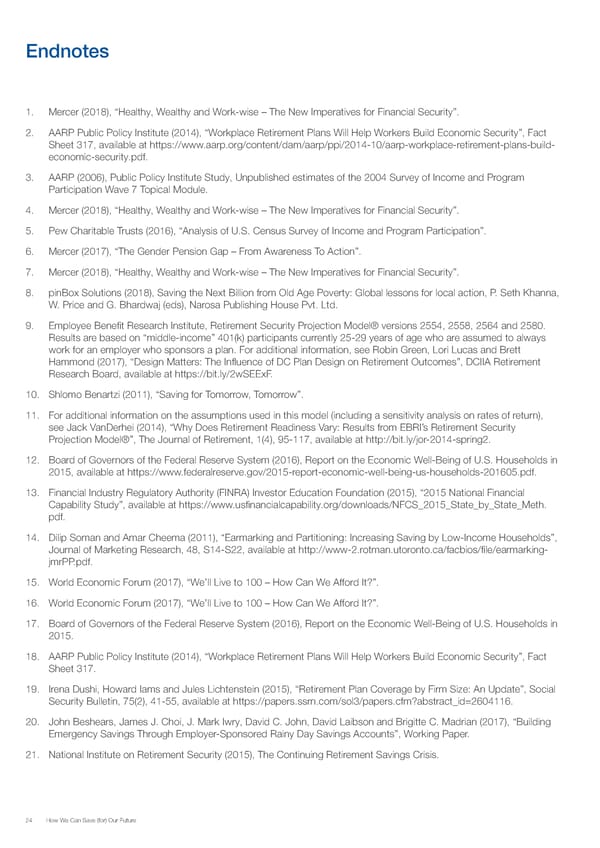Endnotes 1. Mercer (2018), “Healthy, Wealthy and Work-wise – The New Imperatives for Financial Security”. 2. AARP Public Policy Institute (2014), “Workplace Retirement Plans Will Help Workers Build Economic Security”, Fact Sheet 317, available at https://www.aarp.org/content/dam/aarp/ppi/2014-10/aarp-workplace-retirement-plans-build- economic-security.pdf. 3. AARP (2006), Public Policy Institute Study, Unpublished estimates of the 2004 Survey of Income and Program Participation Wave 7 Topical Module. 4. Mercer (2018), “Healthy, Wealthy and Work-wise – The New Imperatives for Financial Security”. 5. Pew Charitable Trusts (2016), “Analysis of U.S. Census Survey of Income and Program Participation”. 6. Mercer (2017), “The Gender Pension Gap – From Awareness To Action”. 7. Mercer (2018), “Healthy, Wealthy and Work-wise – The New Imperatives for Financial Security”. 8. pinBox Solutions (2018), Saving the Next Billion from Old Age Poverty: Global lessons for local action, P. Seth Khanna, W. Price and G. Bhardwaj (eds), Narosa Publishing House Pvt. Ltd. 9. Employee Benefit Research Institute, Retirement Security Projection Model® versions 2554, 2558, 2564 and 2580. Results are based on “middle-income” 401(k) participants currently 25-29 years of age who are assumed to always work for an employer who sponsors a plan. For additional information, see Robin Green, Lori Lucas and Brett Hammond (2017), “Design Matters: The Influence of DC Plan Design on Retirement Outcomes”, DCIIA Retirement Research Board, available at https://bit.ly/2wSEExF. 10. Shlomo Benartzi (2011), “Saving for Tomorrow, Tomorrow”. 11. For additional information on the assumptions used in this model (including a sensitivity analysis on rates of return), see Jack VanDerhei (2014), “Why Does Retirement Readiness Vary: Results from EBRI’s Retirement Security Projection Model®”, The Journal of Retirement, 1(4), 95-117, available at http://bit.ly/jor-2014-spring2. 12. Board of Governors of the Federal Reserve System (2016), Report on the Economic Well-Being of U.S. Households in 2015, available at https://www.federalreserve.gov/2015-report-economic-well-being-us-households-201605.pdf. 13. Financial Industry Regulatory Authority (FINRA) Investor Education Foundation (2015), “2015 National Financial Capability Study”, available at https://www.usfinancialcapability.org/downloads/NFCS_2015_State_by_State_Meth. pdf. 14. Dilip Soman and Amar Cheema (2011), “Earmarking and Partitioning: Increasing Saving by Low-Income Households”, Journal of Marketing Research, 48, S14-S22, available at http://www-2.rotman.utoronto.ca/facbios/file/earmarking- jmrPP.pdf. 15. World Economic Forum (2017), “We’ll Live to 100 – How Can We Afford It?”. 16. World Economic Forum (2017), “We’ll Live to 100 – How Can We Afford It?”. 17. Board of Governors of the Federal Reserve System (2016), Report on the Economic Well-Being of U.S. Households in 2015. 18. AARP Public Policy Institute (2014), “Workplace Retirement Plans Will Help Workers Build Economic Security”, Fact Sheet 317. 19. Irena Dushi, Howard Iams and Jules Lichtenstein (2015), “Retirement Plan Coverage by Firm Size: An Update”, Social Security Bulletin, 75(2), 41-55, available at https://papers.ssrn.com/sol3/papers.cfm?abstract_id=2604116. 20. John Beshears, James J. Choi, J. Mark Iwry, David C. John, David Laibson and Brigitte C. Madrian (2017), “Building Emergency Savings Through Employer-Sponsored Rainy Day Savings Accounts”, Working Paper. 21. National Institute on Retirement Security (2015), The Continuing Retirement Savings Crisis. 24 How We Can Save (for) Our Future
 How can we save for our future Page 23 Page 25
How can we save for our future Page 23 Page 25